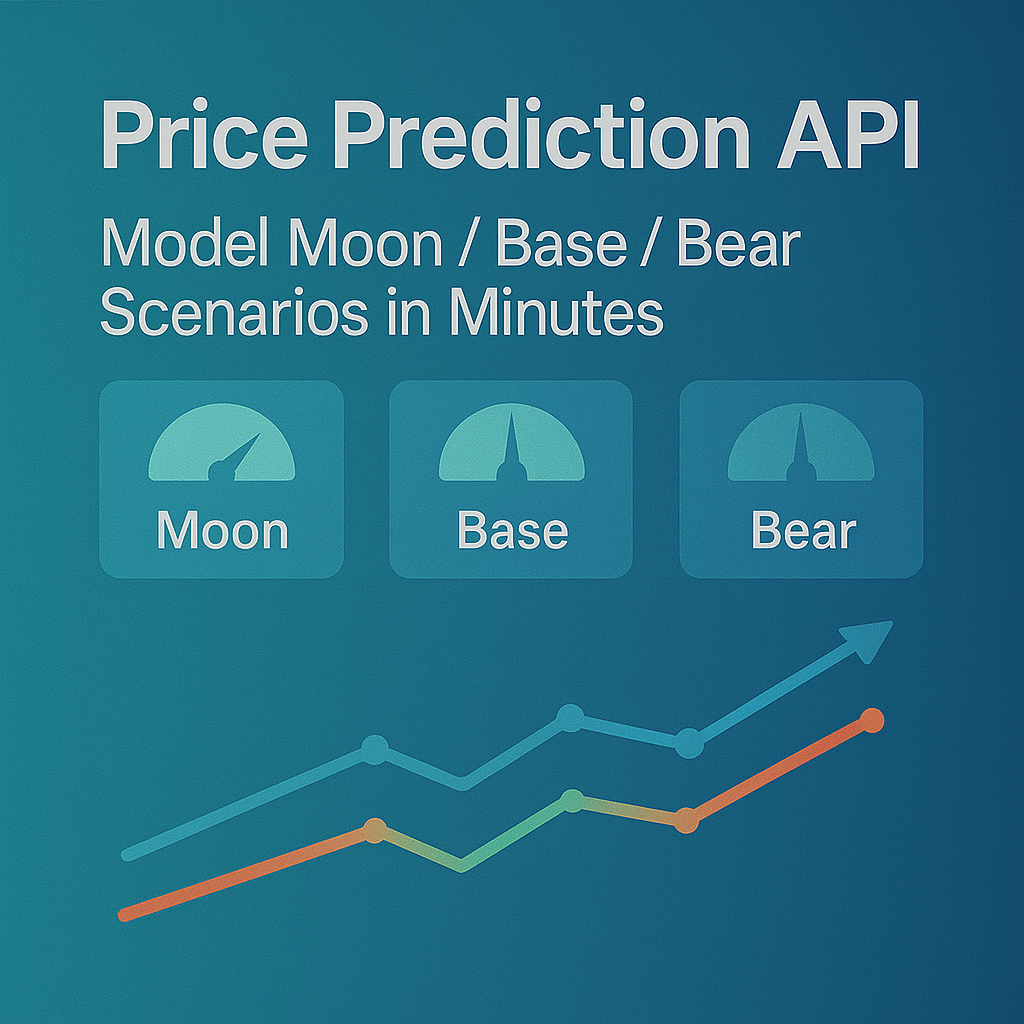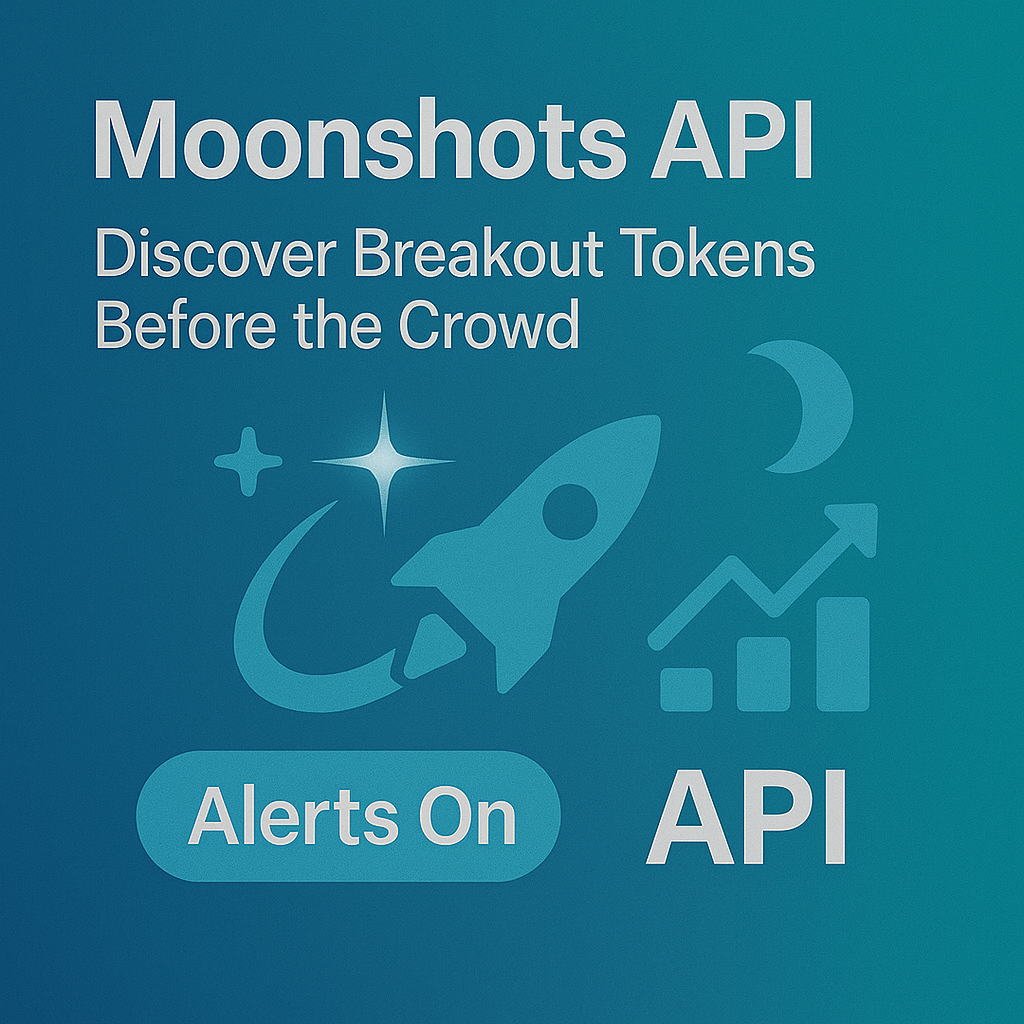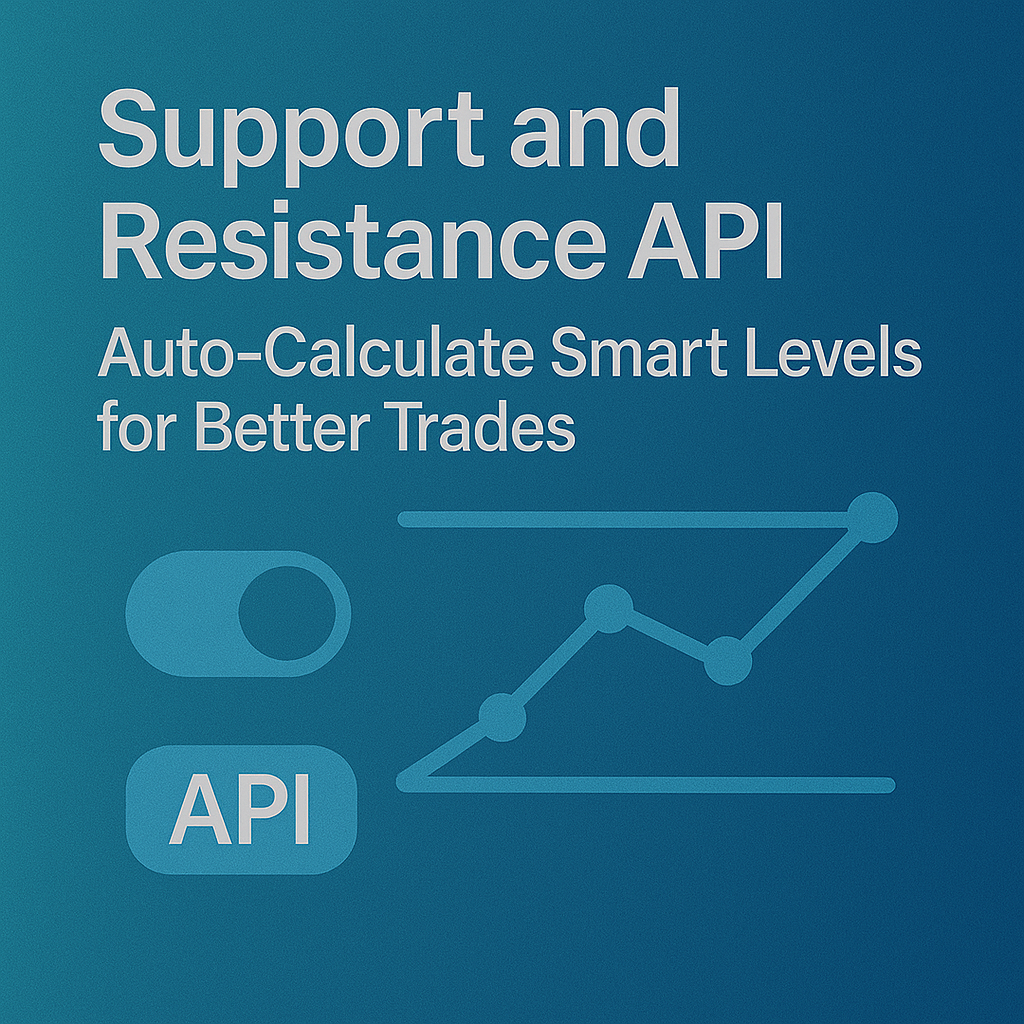Top Crypto Trading Platforms in 2025







%201.svg)
%201.svg)
Big news: We’re cranking up the heat on AI-driven crypto analytics with the launch of the Token Metrics API and our official SDK (Software Development Kit). This isn’t just an upgrade – it's a quantum leap, giving traders, hedge funds, developers, and institutions direct access to cutting-edge market intelligence, trading signals, and predictive analytics.
Crypto markets move fast, and having real-time, AI-powered insights can be the difference between catching the next big trend or getting left behind. Until now, traders and quants have been wrestling with scattered data, delayed reporting, and a lack of truly predictive analytics. Not anymore.
The Token Metrics API delivers 32+ high-performance endpoints packed with powerful AI-driven insights right into your lap, including:
Getting started with the Token Metrics API is simple:
At Token Metrics, we believe data should be decentralized, predictive, and actionable.
The Token Metrics API & SDK bring next-gen AI-powered crypto intelligence to anyone looking to trade smarter, build better, and stay ahead of the curve. With our official SDK, developers can plug these insights into their own trading bots, dashboards, and research tools – no need to reinvent the wheel.
%201.svg)
%201.svg)
The biggest gains in crypto rarely come from the majors. They come from Moonshots—fast-moving tokens with breakout potential. The Moonshots API surfaces these candidates programmatically so you can rank, alert, and act inside your product. In this guide, you’ll call /v2/moonshots, display a high-signal list with TM Grade and Bullish tags, and wire it into bots, dashboards, or screeners in minutes. Start by grabbing your key at Get API Key, then Run Hello-TM and Clone a Template to ship fast.
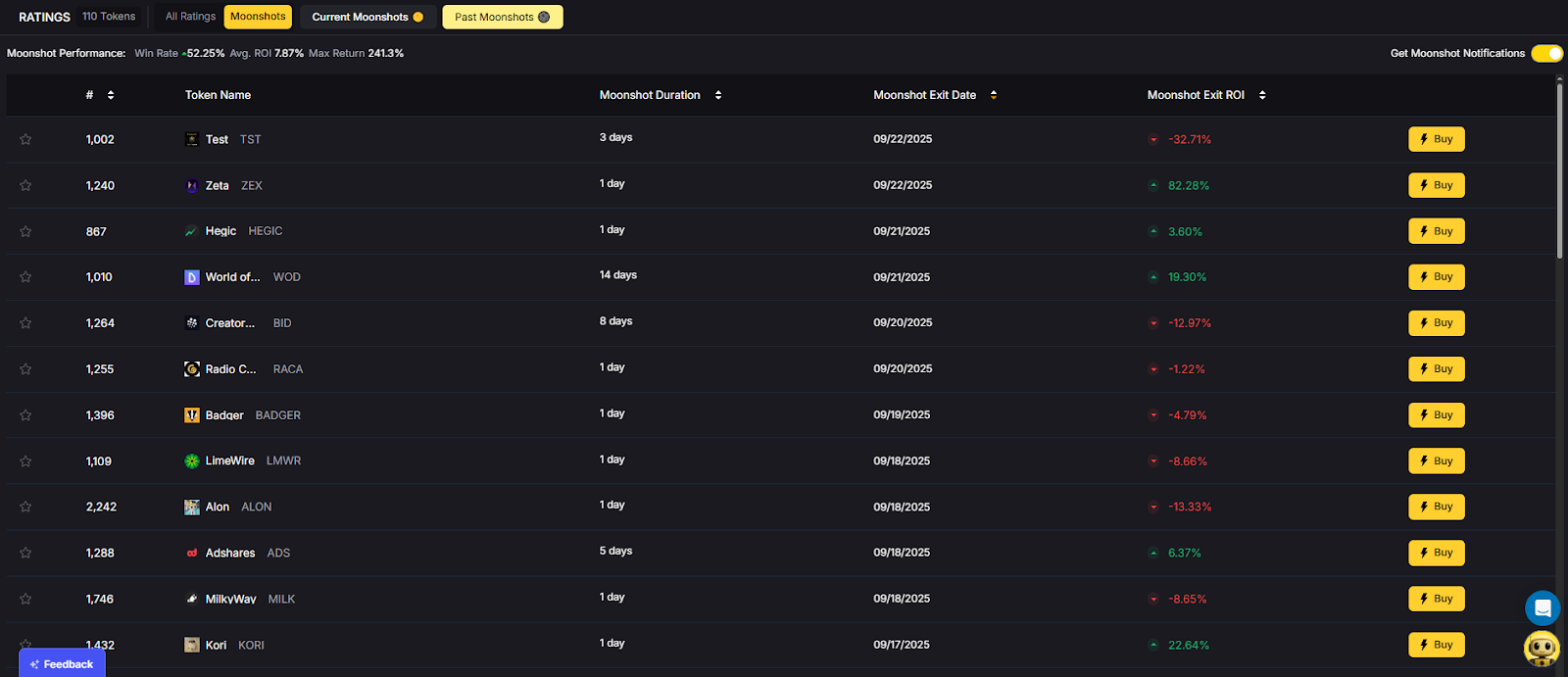
Discovery that converts. Users want more than price tickers—they want a curated, explainable list of high-potential tokens. The moonshots API encapsulates multiple signals into a short list designed for exploration, alerts, and watchlists you can monetize.
Built for builders. The endpoint returns a consistent schema with grade, signal, and context so you can immediately sort, badge, and trigger workflows. With predictable latency and clear filters, you can scale to dashboards, mobile apps, and headless bots without reinventing the discovery pipeline.
The Moonshots API cURL request is right there in the top right of the API Reference. Grab it and start tapping into the potential!
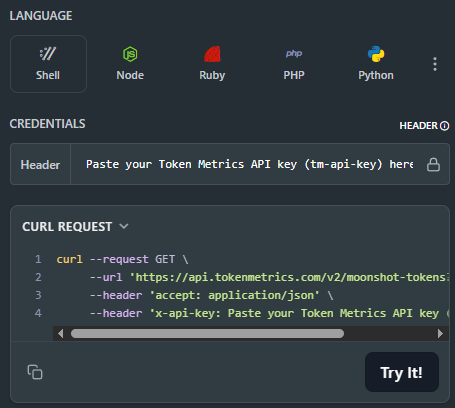
👉 Keep momentum: Get API Key • Run Hello-TM • Clone a Template
Fork a screener or alerting template, plug your key, and deploy. Validate your environment with Hello-TM. When you scale users or need higher limits, compare API plans.
The Moonshots endpoint aggregates a set of evidence—often combining TM Grade, signal state, and momentum/volume context—into a shortlist of breakout candidates. Each row includes a symbol, grade, signal, and timestamp, plus optional reason tags for transparency.
For UX, a common pattern is: headline list → token detail where you render TM Grade (quality), Trading Signals (timing), Support/Resistance (risk placement), Quantmetrics (risk-adjusted performance), and Price Prediction scenarios. This lets users understand why a token was flagged and how to act with risk controls.
Polling vs webhooks. Dashboards typically poll with short-TTL caching. Alerting flows use scheduled jobs or webhooks (where available) to smooth traffic and avoid duplicates. Always make notifications idempotent.
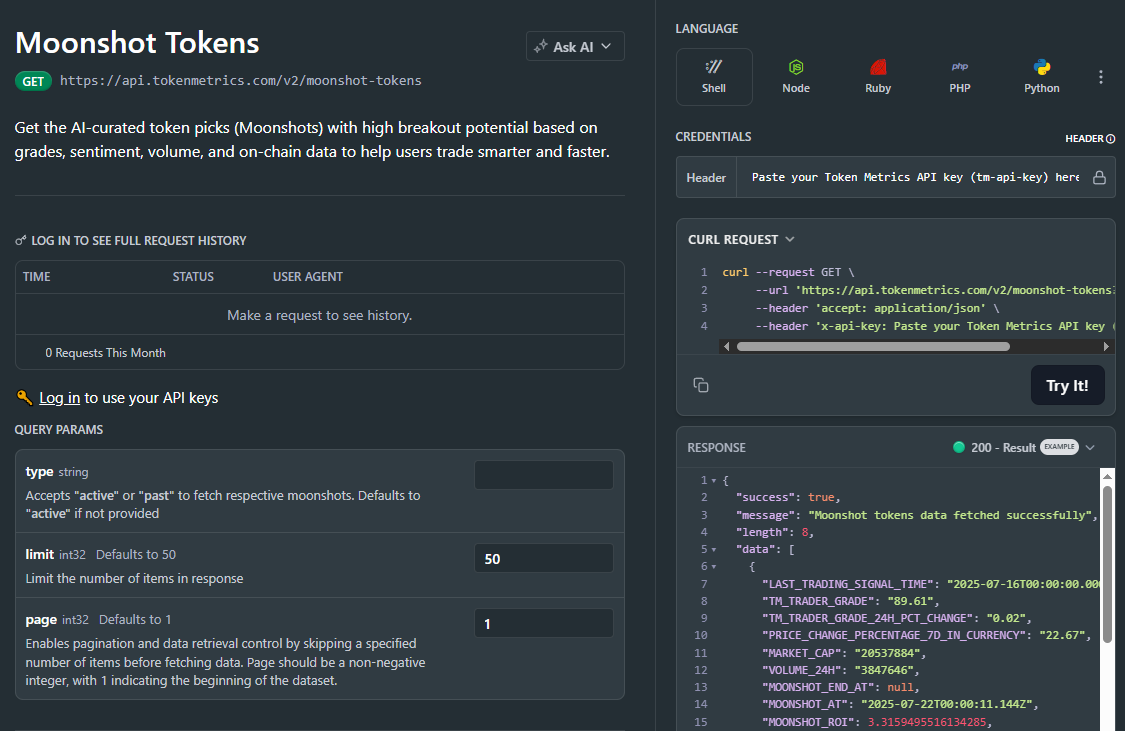
1) What does the Moonshots API return?
A list of breakout candidates with fields such as symbol, tm_grade, signal (often Bullish/Bearish), optional reason tags, and updated_at. Use it to drive discover tabs, alerts, and watchlists.
2) How fresh is the list? What about latency/SLOs?
The endpoint targets predictable latency and timely updates for dashboards and alerts. Use short-TTL caching and queued jobs/webhooks to avoid bursty polling.
3) How do I use Moonshots in a trading workflow?
Common stack: Moonshots for discovery, Trading Signals for timing, Support/Resistance for SL/TP, Quantmetrics for sizing, and Price Prediction for scenario context. Always backtest and paper-trade first.
4) I saw results like “+241%” and a “7.5% average return.” Are these guaranteed?
No. Any historical results are illustrative and not guarantees of future performance. Markets are risky; use risk management and testing.
5) Can I filter the Moonshots list?
Yes—pass parameters like min_grade, signal, and limit (as supported) to tailor to your audience and keep pages fast.
6) Do you provide SDKs or examples?
REST works with JavaScript and Python snippets above. Docs include quickstarts, Postman collections, and templates—start with Run Hello-TM.
7) Pricing, limits, and enterprise SLAs?
Begin free and scale up. See API plans for rate limits and enterprise options.
%201.svg)
%201.svg)
Most traders still draw lines by hand in TradingView. The support and resistance API from Token Metrics auto-calculates clean support and resistance levels from one request, so your dashboard, bot, or alerts can react instantly. In minutes, you’ll call /v2/resistance-support, render actionable levels for any token, and wire them into stops, targets, or notifications. Start by grabbing your key on Get API Key, then Run Hello-TM and Clone a Template to ship a production-ready feature fast.
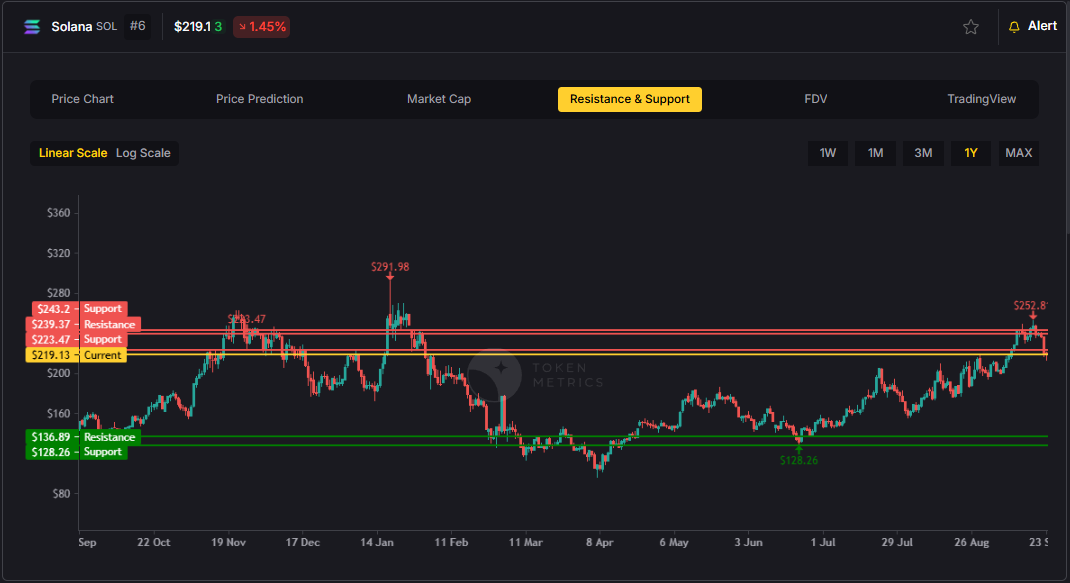
Precision beats guesswork. Hand-drawn lines are subjective and slow. The support and resistance API standardizes levels across assets and timeframes, enabling deterministic stops and take-profits your users (and bots) can trust.
Production-ready by design. A simple REST shape, predictable latency, and clear semantics let you add levels to token pages, automate SL/TP alerts, and build rule-based execution with minimal glue code.
Need the Support and Resistance data? The cURL request for it is in the top right of the API Reference for quick access.
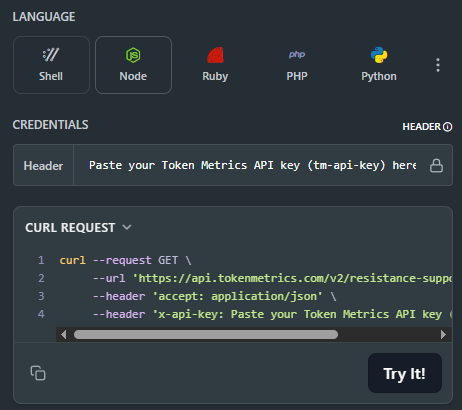
👉 Keep momentum: Get API Key • Run Hello-TM • Clone a Template
Kick off with our quickstarts—fork a bot or dashboard template, plug your key, and deploy. Confirm your environment by Running Hello-TM. When you’re scaling or need webhooks/limits, review API plans.
The Support/Resistance endpoint analyzes recent price structure to produce discrete levels above and below current price, along with strength indicators you can use for priority and styling. Query /v2/resistance-support?symbol=<ASSET>&timeframe=<HORIZON> to receive arrays of level objects and timestamps.
Polling vs webhooks. For dashboards, short-TTL caching and batched fetches keep pages snappy. For bots and alerts, use queued jobs or webhooks (where applicable) to avoid noisy, bursty polling—especially around market opens and major events.
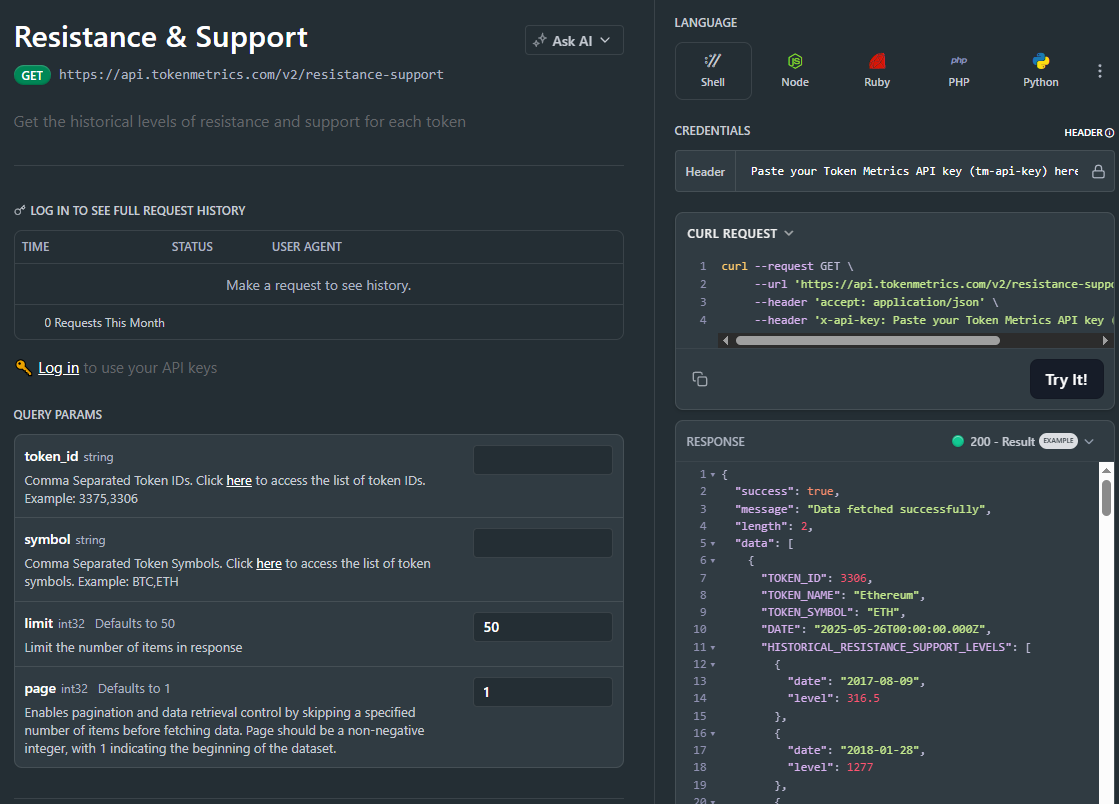
1) What does the Support & Resistance API return?
A JSON payload with arrays of support and resistance levels for a symbol (and optional timeframe), each with a price and strength indicator, plus an update timestamp.
2) How timely are the levels? What are the latency/SLOs?
The endpoint targets predictable latency suitable for dashboards and alerts. Use short-TTL caching for UIs, and queued jobs or webhooks for alerting to smooth traffic.
3) How do I trigger alerts or trades from levels?
Common patterns: alert when price is within X% of a level, touches a level, or breaks beyond with confirmation. Always make downstream actions idempotent and respect rate limits.
4) Can I combine levels with other endpoints?
Yes—pair with /v2/trading-signals for timing, /v2/tm-grade for quality context, and /v2/quantmetrics for risk sizing. This yields a complete decide-plan-execute loop.
5) Which timeframe should I use?
Intraday bots prefer shorter horizons; swing/position dashboards use daily or higher-timeframe levels. Offer a timeframe toggle and cache results per setting.
6) Do you provide SDKs or examples?
Use the REST snippets above (JS/Python). The docs include quickstarts, Postman collections, and templates—start with Run Hello-TM.
7) Pricing, limits, and enterprise SLAs?
Begin free and scale as you grow. See API plans for rate limits and enterprise SLA options.
%201.svg)
%201.svg)
Most traders see price—quants see probabilities. The Quantmetrics API turns raw performance into risk-adjusted stats like Sharpe, Sortino, volatility, drawdown, and CAGR so you can compare tokens objectively and build smarter bots and dashboards. In minutes, you’ll query /v2/quantmetrics, render a clear performance snapshot, and ship a feature that customers trust. Start by grabbing your key at Get API Key, Run Hello-TM to verify your first call, then Clone a Template to go live fast.
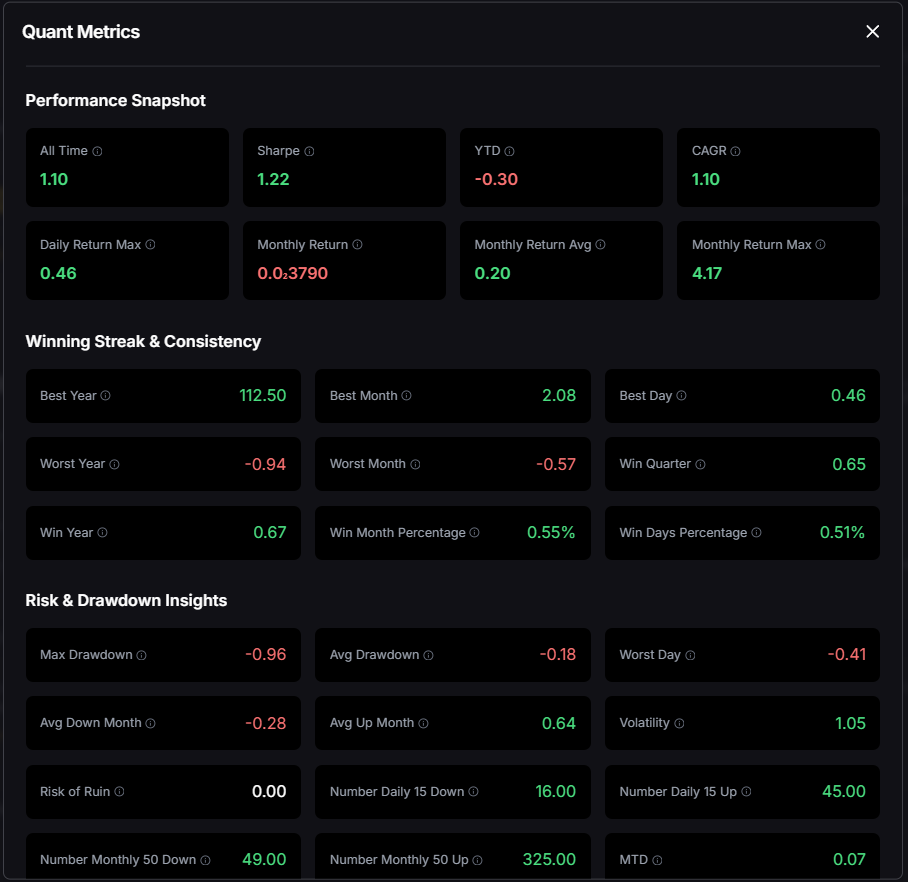
Risk-adjusted truth beats hype. Price alone hides tail risk and whipsaws. Quantmetrics compresses edge, risk, and consistency into metrics that travel across assets and timeframes—so you can rank universes, size positions, and communicate performance like a pro.
Built for dev speed. A clean REST schema, predictable latency, and easy auth mean you can plug Sharpe/Sortino into bots, dashboards, and screeners without maintaining your own analytics pipeline. Pair with caching and batching to serve fast pages at scale.
The Quant Metrics cURL request is located in the top right of the API Reference, allowing you to easily integrate it with your application.
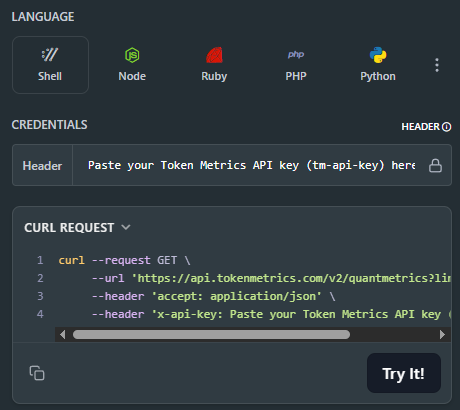
👉 Keep momentum: Get API Key • Run Hello-TM • Clone a Template
Kick off from quickstarts in the docs—fork a dashboard or screener template, plug your key, and deploy in minutes. Validate your environment with Run Hello-TM; when you need more throughput or webhooks, compare API plans.
Quantmetrics computes risk-adjusted performance over a chosen lookback (e.g., 30d, 90d, 1y). You’ll receive a JSON snapshot with core statistics:
Call /v2/quantmetrics?symbol=<ASSET>&window=<LOOKBACK> to fetch the current snapshot. For dashboards spanning many tokens, batch symbols and apply short-TTL caching. If you generate alerts (e.g., “Sharpe crossed 1.5”), run a scheduled job and queue notifications to avoid bursty polling.
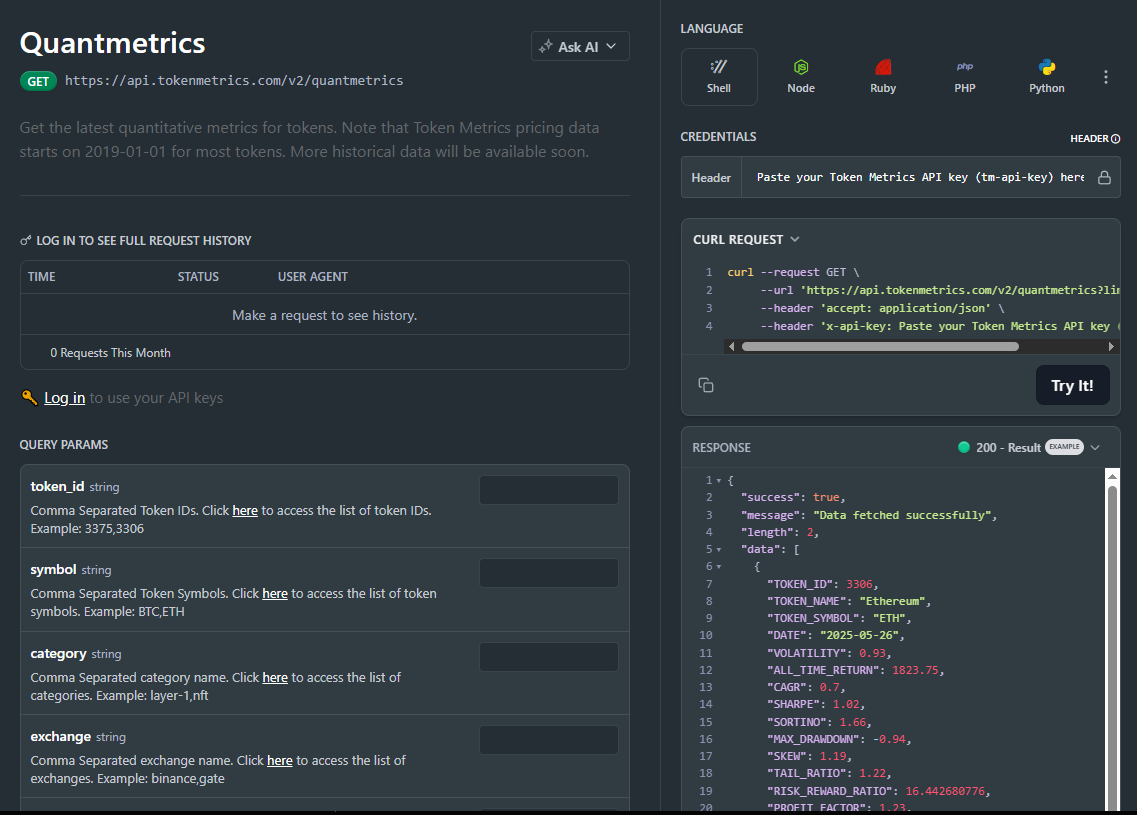
1) What does the Quantmetrics API return?
A JSON snapshot of risk-adjusted metrics (e.g., Sharpe, Sortino, volatility, max drawdown, CAGR) for a symbol and lookback window—ideal for ranking, sizing, and dashboards.
2) How fresh are the stats? What about latency/SLOs?
Responses are engineered for predictable latency. For heavy UI usage, add short-TTL caching and batch requests; for alerts, use scheduled jobs or webhooks where available.
3) Can I use Quantmetrics to size positions in a live bot?
Yes—many quants size inversely to volatility or require Sharpe ≥ X to trade. Always backtest and paper-trade before going live; past results are illustrative, not guarantees.
4) Which lookback window should I choose?
Short windows (30–90d) adapt faster but are noisier; longer windows (6–12m) are steadier but slower to react. Offer users a toggle and cache each window.
5) Do you provide SDKs or examples?
REST is straightforward (JS/Python above). Docs include quickstarts, Postman collections, and templates—start with Run Hello-TM.
6) Polling vs webhooks for quant alerts?
Dashboards usually use cached polling. For threshold alerts (e.g., Sharpe crosses 1.0), run scheduled jobs and queue notifications to keep usage smooth and idempotent.
7) Pricing, limits, and enterprise SLAs?
Begin free and scale up. See API plans for rate limits and enterprise SLA options.

%201.svg)
%201.svg)
Moonshot investing in crypto is a double-edged sword. On one side, you have tokens that can 10x, 50x, or even 100x your portfolio. On the other side? Complete capital loss. While these asymmetric bets can lead to explosive profits, they also carry extreme risk—especially for uninformed or impulsive investors.
This guide will break down the risk landscape of moonshots: what makes them so volatile, common pitfalls to avoid, risk management strategies, and how tools like Token Metrics help reduce blind spots when betting on the next big thing.
Moonshots live in the outer rim of the crypto market. They are typically:
These factors create an environment where price moves fast—but fundamentals are often thin. You're betting more on potential than proof.

You must assume every moonshot has some of these risk factors — and plan accordingly.

Moonshots = high variance. Don’t treat them like stable assets.

If you answer “no” to 2 or more of these, tread cautiously.
Token Metrics helps de-risk moonshots by analyzing over 80+ data points using AI and quant models:
You get a comprehensive view of upside and downside before making a decision.
Moonshot investing is mental warfare. Stick to frameworks, not FOMO.
The path to 100x gains in crypto will always be riddled with landmines. But risk isn’t inherently bad — it’s the price of asymmetric upside. The real danger is unmanaged risk, impulsive decisions, and poor research.
With the right approach, the right tools, and a clear head, moonshot investing can be one of the most rewarding strategies in crypto.
Just remember: You only need to be right once.

%201.svg)
%201.svg)
When most people think “moonshot” in crypto, they think of meme coins like Dogecoin, Shiba Inu, or Pepe — volatile, viral, and often with no utility. While it’s true that meme coins have historically delivered explosive returns, they’re just one type of moonshot. In reality, some of the best moonshots are deeply technical projects with innovative real-world use cases.
In this blog, we’ll explore why moonshots go far beyond memes, the other types of high-potential assets you should be watching, and how to distinguish hype from substance in your moonshot hunt.
Meme coins dominate headlines and retail attention for good reason:
Because of these qualities, meme coins are often perceived as the only moonshots. But perception doesn’t equal reality.
Some of the most successful moonshot investments didn’t begin as memes — they were innovative, under-the-radar projects that grew into billion-dollar ecosystems:

None of these were memes — they were tech-focused moonshots.
Here are several non-meme sectors producing moonshot-level gains:
These projects combine visionary ideas with real-world applicability — and many began as stealth moonshots before going mainstream.
Look for:
Meme coins may be powered by emotion — but utility moonshots are powered by execution.
Token Metrics doesn’t just chase hype — it grades thousands of tokens using 80+ data points including:
This means you can discover both emerging meme coins and tech-driven moonshots based on real metrics — not just Twitter noise.
Yes — but they should be treated like short-term plays with proper risk management. When timed right (early launch, CEX rumor, meme trend), meme coins can 10x fast. But unlike utility tokens, meme coins often lack long-term sustainability unless they evolve (like DogeX or SHIB ecosystem).
Use tools like Token Metrics AI Signals to time entries and exits.

Don’t confuse “meme” with “momentum.” Use data.
If your moonshot portfolio is 100% meme coins, you're gambling. If it’s 100% early L1s with no traction, you may be stuck waiting years. Smart investors build a balanced basket that includes:
Meme coins are just one path to the moon — don’t miss the others.

%201.svg)
%201.svg)
Everyone wants to catch the next 100x token before it explodes. The real trick isn’t riding the hype — it’s getting in before the hype begins. That’s where the real alpha is. Early entry into promising crypto moonshots gives you a massive edge, but how do you consistently find these hidden gems before they go viral?
This guide breaks down where early-stage opportunities hide, what tools to use, and how smart investors separate real moonshots from noise.
Being early doesn’t mean buying after it’s on Coinbase or featured by YouTubers. It means:
Getting in early usually involves doing the work—but tools and tactics can help.
The fastest-moving crypto intelligence hub. Look for:
These platforms often list early-stage projects before they go mainstream:
Subreddits like r/cryptomoonshots and r/AltcoinDiscussion are full of degens sniffing out new coins. Just beware of shills.
Private Discords like Token Metrics or paid alpha communities provide filtered insights from experts.
The Token Metrics AI tools analyze thousands of tokens and surfaces early movers based on:

If it checks 3–5 of these boxes and you’re early? It might be worth a bet.
Watch out for these signals across Twitter, Telegram, and DEX listings:
Example: If you see a project listed on GeckoTerminal, surging in volume, mentioned in a Token Metrics Bullish Signal — that’s a sign to dig deeper.
Combine tools to validate your picks from multiple angles.

Let’s say you spotted Bonk (BONK) on Solana in December 2022:
If you got in pre-hype, your 10x to 50x gains were very possible.
Even if you’re early, avoid traps:
Early doesn’t always mean safe. Do your due diligence.
With the Token Metrics platform, you can:
That’s how you go from guessing to investing.
In crypto, timing is everything. If you can consistently find promising moonshots before they hit the mainstream, the upside is massive. But it takes strategy, tools, and a data-first mindset.
By combining on-chain signals, AI analysis, narrative momentum, and community validation, you can sharpen your edge — and maybe catch the next Shiba, Pepe, or Solana before the crowd.

%201.svg)
%201.svg)
In the fast-paced world of cryptocurrency, a “moonshot” refers to a crypto project or token that has the potential to achieve explosive, exponential gains — often 10x, 50x, or even 100x returns. The term originates from the phrase “to the moon,” a popular crypto meme used when the price of a coin skyrockets. Moonshots are speculative plays, typically centered around new, low market-cap projects that haven’t yet caught the mainstream’s attention.
While the rewards can be life-changing, the risks are equally significant. In this guide, we’ll explore what makes a crypto asset a moonshot, how to spot one early, the risk/reward tradeoff, and how you can approach moonshots like a pro.
A moonshot crypto token isn’t just any new coin — it’s one with specific characteristics that make it ripe for explosive growth, including:
In short, moonshots are asymmetric bets. You risk a small amount for the chance of a massive return.
Moonshots appeal to both degens and visionary investors alike for one key reason: life-changing upside. A $1,000 investment in a 100x coin could turn into $100,000. That level of ROI is hard to find in any other asset class.
And unlike large-cap coins like Bitcoin or Ethereum, where double-digit gains are celebrated, moonshots are expected to multiply in value several times over — often within months.
For all their upside, moonshots come with steep risks:
Many moonshot projects don’t have sustainable business models, and some may never deliver a product. That’s why proper research and risk management are essential.
Here are a few historical examples of coins that were considered moonshots before they exploded:
Each of these projects had early believers who saw the potential before the crowd caught on.
Here are key areas to assess when evaluating a potential moonshot:

Pro tip: Use tools like Token Metrics AI Grades to scan hundreds of low-cap tokens and detect promising moonshots early using data-driven metrics.

If you’re a long-term investor, moonshots should make up only a small percentage of your portfolio.
Moonshots are all about timing. Catching a token before it gets listed on major exchanges or gains influencer exposure is key. Once the herd finds it, the 100x opportunity is usually gone.
Best times to enter include:
Only if you’re willing to lose what you invest. Moonshots are not for the faint of heart. They are ideal for small, high-risk allocations in your portfolio — think of them as lottery tickets with better odds, provided you do your homework.
To succeed in moonshot investing:
Moonshots are where fortunes are made and lost. While they offer some of the most exciting opportunities in crypto, they require discipline, deep research, and a healthy risk appetite. Whether you're looking to turn $500 into $50,000 or simply want to understand what drives explosive gains in the crypto space, moonshots are a critical concept to grasp.

%201.svg)
%201.svg)
With the explosion of cryptocurrencies, narratives, and sectors in 2025, the question for many investors is no longer should I invest in crypto—but how. For those looking for diversified, smart exposure, crypto indices have become the go-to option.
But what is the best crypto index in 2025?
In this guide, we’ll explore the top-performing crypto indices of the year, what makes them effective, and how to choose the best index for your goals—whether you want passive exposure, thematic investing, or AI-powered optimization.
Before naming names, it’s important to understand the criteria that define a top crypto index:
Returns compared to BTC, ETH, and market benchmarks
Ability to avoid deep drawdowns and protect capital
Exposure to emerging trends like AI, Memecoins, RWA, or DeFi
How frequently and intelligently the index adjusts
Ease of investing, transparency, and platform reliability
Here are the top crypto indices dominating investor attention in 2025:
Type: AI-Powered
Strategy: Weekly dynamic rebalancing
Constituents: DOGE, SHIB, PEPE, WIF, BONK, FLOKI
Why It’s a Top Pick:
Memecoins dominated the first half of 2025. This AI-managed index captured upside by reallocating into trending tokens and exiting early during corrections. While risky, its weekly AI signals helped outperform most passive strategies.
Ideal For:
High-risk, high-reward investors looking to ride viral trends with smart protection.
Type: AI-Powered
Strategy: Bullish/bearish signals per token
Constituents: AAVE, UNI, LDO, RUNE, GMX, DYDX
Why It’s a Top Pick:
DeFi remains a foundational sector. The AI DeFi Index adapts to fast-changing liquidity trends and trading volumes. It reduces exposure to underperformers and increases weight in strong, breakout tokens.
Ideal For:
Long-term crypto believers who want smarter DeFi exposure with reduced risk.
Type: Market Cap Passive
Strategy: Holds top 10 coins by market cap
Constituents: BTC, ETH, SOL, BNB, ADA, etc.
Why It’s a Top Pick:
For conservative investors or institutions, Bitwise offers a simple, regulated way to get exposure to the largest digital assets. While it doesn’t capture emerging trends, it offers long-term stability.
Ideal For:
Traditional investors and institutions entering crypto via regulated vehicles.
Type: AI-Powered
Strategy: Thematic with dynamic risk adjustment
Constituents: MKR, ONDO, XDC, POLYX, CFG
Why It’s a Top Pick:
The Real World Asset narrative surged in 2025, driven by tokenized treasuries and institutional adoption. This index captured the upside while avoiding the fluff.
Ideal For:
Investors looking for exposure to crypto’s real-world utility and stable growth themes.
Type: Passive
Strategy: Weighted DeFi exposure
Constituents: AAVE, UNI, COMP, SNX, LRC
Why It’s a Top Pick:
One of the earliest thematic indices, DPI remains a favorite among DeFi-focused users who prefer full on-chain transparency and DAO governance.
Ideal For:
DeFi-native investors who want decentralized, trustless exposure.
The best crypto index isn’t universal—it depends on your risk tolerance, time horizon, and investment goals.
Here’s a breakdown:

Passive indices work well for long-term exposure to top tokens, but AI indices have outperformed in 2025 thanks to their ability to:
Platforms like Token Metrics offer weekly rebalanced AI indices that are tuned to market momentum, sentiment, and volatility.

Note: Returns are hypothetical and reflect aggregated performance snapshots.
The best crypto index in 2025 is the one that aligns with your goals and risk profile.
Crypto indices take the guesswork out of investing, allowing you to benefit from market trends without managing dozens of individual tokens.

%201.svg)
%201.svg)
The crypto market in 2025 is more advanced, more crowded, and more volatile than ever before. Thousands of tokens compete for attention, and prices can move dramatically in hours. For many investors—especially those who want to participate without day-trading—crypto index investing is the smartest and simplest way to grow wealth in the digital asset space.
But what exactly are the benefits of investing in a crypto index?
In this article, we’ll walk through the major advantages of crypto index investing—especially compared to picking individual tokens—and explain why more investors are turning to indices for long-term success.
A crypto index is a curated portfolio of cryptocurrencies bundled together to represent a market segment, investment strategy, or theme. It works just like an index fund or ETF in traditional finance—except it’s built for the crypto world.
Popular types of indices include:
Perhaps the biggest benefit of a crypto index is built-in diversification. Instead of betting on a single token, you gain exposure to multiple assets at once.
This spreads your risk. If one token underperforms or crashes, others in the basket can offset the loss—making your portfolio more resilient.
Example:
A DeFi Index might hold AAVE, UNI, LDO, and GMX. If UNI struggles, strong performance from LDO or GMX could still deliver overall gains.
Crypto can be complex—new tokens launch daily, narratives shift, and technical analysis isn’t for everyone.
Indices simplify your decision-making. You don’t need to constantly:
Instead, you choose an index that fits your goals, invest once, and let the structure handle the rest.
Most crypto indices rebalance automatically—meaning they adjust the weights of the tokens in the basket based on performance, market cap, or AI-generated signals.
Rebalancing helps:
For example, Token Metrics AI Indices rebalance weekly based on 80+ data points per token, including volatility, momentum, and sentiment.
Crypto moves in narratives: AI, Memecoins, Real World Assets (RWA), Gaming, and more. Sector-based indices allow you to invest in these narratives without trying to guess which token will lead the trend.
Want to ride the AI boom? Buy an AI Tokens Index.
Want exposure to new L1 blockchains? Choose a Layer 1 Index.
Thematic investing through indices is one of the most effective ways to align with where capital is flowing.
Individual tokens can be incredibly volatile—and if you choose the wrong one, your entire investment may collapse.
Indices smooth out volatility by combining multiple tokens. While the overall market is still risky, your exposure is far more controlled.
AI-powered indices go even further by:
This is dynamic risk management, not just passive exposure.
Let’s face it—crypto investors are often their own worst enemies.
Index investing removes these human emotions. Your portfolio follows rules, not feelings. Whether it’s a passive index or an AI-managed one, you gain disciplined, unemotional investing.
Crypto indices are now easier than ever to access. Most platforms allow you to start investing with as little as $50 to $100.
Depending on the platform, you can:
This makes crypto indexing ideal for beginners, busy professionals, and even institutions.
Passive indices offer simplicity and safety. But if you want to outperform the market, AI-powered indices give you an edge.
Token Metrics AI Indices, for example:
In 2024 and early 2025, many AI indices beat market cap indices by double-digit margins—especially during volatile market phases.
Let’s say you want to invest in DeFi but don’t know which tokens to pick.
You choose the Token Metrics AI DeFi Index. It currently includes:
Each week, it checks market signals. If LDO looks weak, the index might reduce exposure and allocate more to DYDX. If the entire market looks bearish, it might reduce risk by shifting into USDC.
You don’t need to lift a finger—but your portfolio stays optimized.

Whether you're new to crypto or looking to upgrade your portfolio strategy, crypto indices offer unmatched benefits in 2025:
Platforms like Token Metrics offer next-generation AI-driven indices tailored to your goals, helping you grow your portfolio while reducing the stress of crypto investing.
If you want to participate in crypto’s upside without constantly worrying about the downside, crypto indices are your best bet.

%201.svg)
%201.svg)
The world of crypto investing is known for its high risk and high reward. With extreme price swings, rug pulls, and market crashes, it’s no surprise that many investors are looking for safer ways to participate in the crypto market. One such method gaining popularity in 2025 is investing in crypto indices.
But how safe is investing in a crypto index?
In this article, we’ll explore the risks and benefits of crypto index investing, compare it to other strategies like trading individual tokens, and help you understand what “safe” really means in the context of crypto.
A crypto index is a curated basket of cryptocurrencies designed to track the performance of a specific segment of the market. Indices can be based on market cap (e.g., Top 10), themes (e.g., DeFi, AI, Memecoins), or even powered by AI that adjusts the portfolio based on market signals.
Rather than investing in a single token, you gain diversified exposure across multiple tokens—similar to how mutual funds or ETFs work in traditional finance.
By holding multiple assets, a crypto index spreads out the risk. If one token collapses, others in the basket may still perform well—minimizing portfolio damage.
Example:
If your Memecoin Index includes DOGE, SHIB, PEPE, and WIF, and one crashes, the others may rise, balancing your returns.
Many investors lose money by panic selling, FOMO buying, or making emotional trades. Indices are rule-based or AI-driven—removing emotion from the equation.
AI-powered indices, like those from Token Metrics, automatically rebalance based on data, not gut feelings.
While no crypto product is immune to volatility, AI-managed indices can exit positions in bear markets or shift capital into stablecoins when risk signals appear.
This dynamic risk management offers better downside protection than static HODL strategies.
Index criteria often exclude low-liquidity or high-risk assets. Most indices include tokens with:
This filters out scams or dead projects.
Absolutely not. There is no such thing as a risk-free investment in crypto. Here are the real risks to be aware of when investing in indices:
Crypto indices still follow the broader market. If Bitcoin and Ethereum crash, most indices will drop too—especially those based on market cap.
If you're investing in on-chain, tokenized indices (e.g., via Phuture or Index Coop), you’re relying on smart contracts. Bugs, exploits, or hacks are possible.
Some indices have poor construction—wrong weighting, bad rebalancing logic, or flawed token selection. Always review the index methodology.
If the platform offering the index is centralized and shuts down, your access to the portfolio may be impacted. Choose reputable, audited platforms like Token Metrics or Bitwise.

AI indices may provide better protection in volatile markets, as they can:
Token Metrics AI Indices, for example, are updated weekly based on 20+ data points per token.

Crypto indices strike a balance between control, risk management, and simplicity. They reduce your chance of making bad trades while still giving you exposure to market growth.
Crypto indices are ideal for beginners. You don’t need to understand complex tokenomics or track every coin. Just pick a theme, invest, and let the index do the work.
If you want long-term exposure without daily management, indices (especially market cap-based) are safer than trading.
Even advanced traders use indices to hedge risk or allocate a portion of their capital to automated strategies.
During a recent correction, the Token Metrics AI DeFi Index:
This kind of AI-driven risk management is where the future of safe investing lies.
While no investment is truly “safe” in crypto, crypto index investing significantly reduces your risk compared to individual token trading.
You gain:
If safety is your concern—but you still want to grow your wealth in crypto—start with a well-built index. For the most intelligent protection, explore AI-powered indices like those from Token Metrics, which automatically adjust to market conditions and help reduce risk dynamically.

%201.svg)
%201.svg)
Crypto investing can be overwhelming. With thousands of tokens to choose from, rapidly shifting narratives, and volatile price swings, even seasoned investors struggle to build and manage a balanced portfolio. That’s why crypto indices have become increasingly popular in 2025.
But how exactly does a crypto index work?
In this article, we’ll break down the mechanics of how crypto indices function, from token selection and weighting to rebalancing and performance tracking. By the end, you’ll understand how these powerful tools simplify crypto investing—and how you can take full advantage of them.
A crypto index is a structured portfolio of cryptocurrencies grouped together based on a common methodology. It represents a specific part of the market—such as the top 10 coins by market cap, the leading DeFi protocols, or trending tokens in a sector like AI or gaming.
Just like the S&P 500 tracks the performance of top U.S. companies, a crypto index tracks the collective performance of selected tokens.
Let’s explore how a typical crypto index operates step-by-step:
Every index starts with a set of criteria to determine which cryptocurrencies will be included.
The goal is to select a diversified set of tokens that represents the chosen segment of the market.
Once tokens are selected, the index must decide how much of each token to include.
Weighting determines how performance from each token impacts the overall index return.
Markets are always changing. Rebalancing is the process of adjusting the portfolio to maintain the target weights and remove underperforming assets.
Example:
If a memecoin in your index pumps and takes up 60% of the portfolio, rebalancing brings it back down to its intended 20%—locking in gains and reducing risk.
An index’s value is calculated based on the performance of its underlying assets and their respective weights.
The formula is similar to a weighted average return. For tokenized indices, the value is often represented as an Index Token Price.
Performance is typically measured:
Investors track these returns to compare index performance against benchmarks like Bitcoin or Ethereum.
To invest in an index, you typically:
Some platforms issue tokenized representations (ERC-20 index tokens), while others manage indices off-chain.
Let’s look at an AI-powered index on Token Metrics called the AI Tokens Index.
Outcome: Better risk-adjusted performance in volatile markets compared to static, passive indices.

Accurate pricing, volume, volatility, and liquidity data are critical for proper index functioning.
Manage token weights, execute trades, and handle rebalancing autonomously.
For AI or technical indices, algorithms analyze trends, patterns, and market signals to inform decisions.
Both exist.
In 2025, hybrid indices—that blend passive structure with active rebalancing—are becoming more popular.
Understanding how a crypto index works helps you make better investment decisions. You’ll know:
Crypto indices aren’t just simplified baskets—they are dynamic, data-driven tools that reflect the market in motion. Whether you choose a passive index or an AI-powered one, understanding the mechanics ensures you’re investing with clarity—not blind trust.
For smarter, automated exposure to the crypto market, consider using platforms like Token Metrics, which offer both passive HODL indices and advanced AI indices that rebalance weekly based on real market signals.

%201.svg)
%201.svg)
A Bitcoin index fund is a financial product designed to provide investors with exposure to Bitcoin—and often other leading cryptocurrencies—through a single, diversified investment. Much like a traditional stock market index fund (like the S&P 500), a Bitcoin index fund tracks a basket of top crypto assets, eliminating the need to buy and manage each one individually.
The purpose of a Bitcoin index fund is simple: make crypto investing easier, safer, and more diversified. Rather than picking individual tokens, investors buy shares in the fund, which automatically rebalances according to predefined rules—usually based on market capitalization.
If you're looking for the best index fund in the crypto space in 2025, platforms like Token Metrics offer a new generation of AI-powered index products that provide dynamic exposure to Bitcoin and other high-performing digital assets.
Index funds are a staple of traditional finance because they offer:
A bitcoin index fund brings those same benefits to the crypto world—especially important given the volatility and complexity of managing a portfolio of digital assets.
At its core, a Bitcoin index fund holds a weighted basket of the top cryptocurrencies, with Bitcoin often as the dominant component. Most funds:
For example, a fund like BITW (Bitwise 10 Crypto Index Fund) allows retail and institutional investors to buy crypto exposure directly in their brokerage account, with professional custody, reporting, and risk management.
While traditional crypto index funds trade on brokerage platforms, Token Metrics offers a crypto-native index fund experience—built for on-chain participation with AI-powered asset selection and risk screening.
The Token Metrics Index Fund is:
You can trade on Token Metrics Index Funds directly through the platform, making it the most innovative and flexible solution for modern investors.
Unlike static index funds, the Token Metrics Index platform uses machine learning and real-time analytics to optimize portfolio composition. Every fund is:
Token Metrics assigns Trader and Investor Grades (0–100) to thousands of cryptocurrencies based on technical, fundamental, and sentiment analysis. The highest-graded tokens make it into the index.
Choose from sector-focused indices like:
This allows investors to tailor exposure based on macro trends or investment theses.
Indices are rebalanced automatically when key signals trigger:
This allows you to stay ahead of the market without micromanaging your portfolio.
Gain exposure to Bitcoin and other top assets like Ethereum, Solana, Chainlink, and more—without choosing them manually.
Built-in risk scoring flags tokens with audit failures, low liquidity, or suspicious on-chain behavior—keeping your exposure clean.
Forget guessing. Each asset’s weight is optimized using over 80+ data signals, including social sentiment, tokenomics, whale activity, and developer metrics.
Retain custody of your crypto. Token Metrics doesn’t hold your assets—you do. You execute trades directly through your self-custodial wallet.

Getting started is simple:
You can also set up alerts to track when the index rebalances or when new tokens enter/exit the fund.
If you’re:
…then a Bitcoin index fund—and specifically the Token Metrics Index Fund—is one of the best index fund strategies to consider in 2025.
Crypto is evolving—and so are the tools to invest in it. The days of chasing charts and trying to time every trade are giving way to smarter, more data-driven investing.
Whether you’re managing your first portfolio or optimizing institutional exposure, the Token Metrics Index Fund offers a secure, automated, AI-powered path to diversify into Bitcoin and top-performing crypto assets.
By combining quant-grade analysis with intuitive, on-chain execution, Token Metrics makes it easier than ever to trade on a crypto index fund that works for you—not against you.
Invest smart. Diversify with AI. Trade with confidence on Token Metrics.
🔗 Explore Token Metrics Index Funds
🔗 Start your 7-day free trial
🔗 Access AI research and alerts


 Create Your Free Account
Create Your Free Account9450 SW Gemini Dr
PMB 59348
Beaverton, Oregon 97008-7105 US
.svg)




.png)
Token Metrics Media LLC is a regular publication of information, analysis, and commentary focused especially on blockchain technology and business, cryptocurrency, blockchain-based tokens, market trends, and trading strategies.
Token Metrics Media LLC does not provide individually tailored investment advice and does not take a subscriber’s or anyone’s personal circumstances into consideration when discussing investments; nor is Token Metrics Advisers LLC registered as an investment adviser or broker-dealer in any jurisdiction.
Information contained herein is not an offer or solicitation to buy, hold, or sell any security. The Token Metrics team has advised and invested in many blockchain companies. A complete list of their advisory roles and current holdings can be viewed here: https://tokenmetrics.com/disclosures.html/
Token Metrics Media LLC relies on information from various sources believed to be reliable, including clients and third parties, but cannot guarantee the accuracy and completeness of that information. Additionally, Token Metrics Media LLC does not provide tax advice, and investors are encouraged to consult with their personal tax advisors.
All investing involves risk, including the possible loss of money you invest, and past performance does not guarantee future performance. Ratings and price predictions are provided for informational and illustrative purposes, and may not reflect actual future performance.

